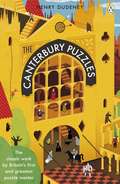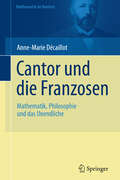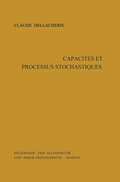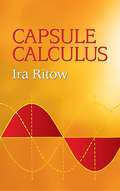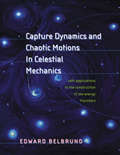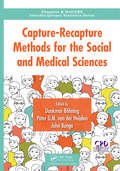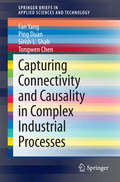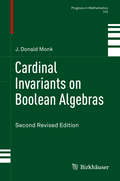- Table View
- List View
Canonical Metrics in Kähler Geometry (Lectures in Mathematics. ETH Zürich)
by Gang TianThere has been fundamental progress in complex differential geometry in the last two decades. For one, The uniformization theory of canonical Kähler metrics has been established in higher dimensions, and many applications have been found, including the use of Calabi-Yau spaces in superstring theory. This monograph gives an introduction to the theory of canonical Kähler metrics on complex manifolds. It also presents some advanced topics not easily found elsewhere.
Canonical Perturbation Theories: Degenerate Systems and Resonance (Astrophysics and Space Science Library #345)
by Sylvio Ferraz-MelloThe book is written mainly to advanced graduate and post-graduate students following courses in Perturbation Theory and Celestial Mechanics. It is also intended to serve as a guide in research work and is written in a very explicit way: all perturbation theories are given with details allowing its immediate application to real problems. In addition, they are followed by examples showing all steps of their application.
Canonical Problems in the Theory of Plasmonics: From 3D to 2D Systems (Springer Series in Optical Sciences #230)
by Afshin MoradiThis book provides a systemic and self-contained guide to the theoretical description of the fundamental properties of plasmonic waves. The field of plasmonics is built on the interaction of electromagnetic radiation and conduction electrons at metallic interfaces or in metallic nanostructures, and so to describe basic plasmonic behavior, boundary-value problems may be formulated and solved using electromagnetic wave theory based on Maxwell’s equations and the electrostatic approximation.In preparation, the book begins with the basics of electromagnetic and electrostatic theories, along with a review of the local and spatial nonlocal plasma model of an electron gas. This is followed by clear and detailed boundary value analysis of both classical three-dimensional and novel two-dimensional plasmonic systems in a range of different geometries. With only general electromagnetic theory as a prerequisite, this resulting volume will be a useful entry point to plasmonic theory for students, as well as a convenient reference work for researchers who want to see how the underlying models can be analysed rigorously.
The Canterbury Puzzles
by Henry DudeneyFor the mastermind who has what it takes to solve the tricky conundrums from Britain's first and greatest puzzle master.---------------------------------------Solve the puzzle of The Mystery of Ravensdene Park . . . trace the route of the butler, the gamekeeper and the two anonymous guests and the key to the mystery will reveal itself.---------------------------------------Decipher the riddle of The Frogs' Ring for The Merry Monks of Riddlewell . . . ---------------------------------------At The Squire's Christmas Puzzle Party ascertain just how many kisses had been given Under the Mistletoe Bough . . . ---------------------------------------First published in 1907, Dudeney's The Canterbury Puzzles is a classic of the genre, based on characters from Chaucer's Tales. The book contains 114 puzzles suitable for young enthusiasts, recreational mathematicians and veteran puzzlers alike. As challenging today as it was over a century ago, this ingenious book will provide hours-worth of puzzles to keep your brain alert."Regular exercise is supposed to be as necessary for the brain as for the body. Many of us are very apt to suffer from mental cobwebs, and there is nothing equal to the solving of puzzles for sweeping them away." - Henry Dudeney (1847-1930)
Cantor und die Franzosen: Mathematik, Philosophie und das Unendliche (Mathematik im Kontext)
by Anne-Marie DécaillotEnde des 19. Jahrhunderts, als Georg Cantor in Halle die Mengenlehre entwickelte, korrespondierte der Mathematiker lebhaft mit zahlreichen französischen Fachkollegen. Diese Briefe nimmt die Autorin zur Grundlage, um im Detail zu beschreiben, wie die Briefpartner um mathematische Begriffe gerungen haben. Eingebettet in den historischen Kontext wird so ein faszinierender Moment in der Geschichte der Mathematik wieder lebendig.
Capacitated Planned Maintenance: Models, Optimization Algorithms, Combinatorial and Polyhedral Properties (Lecture Notes in Economics and Mathematical Systems #686)
by Torben KuschelThis book examines the problem of maintenance planning and scheduling in industrial production systems. It presents two practically relevant, deterministic mathematical models: the capacitated planned maintenance problem (CPMP) and the weighted uncapacitated planned maintenance problem (WUPMP). It introduces specific optimization algorithms such as construction heuristics, Lagrangean and tabu search metaheuristics. A problem independent hybrid approach links and alternates between two Lagrangean relaxations. It also analyzes the solvability with respect to the computational complexity of several problem classes, polyhedral properties and lower bounds. Computational studies demonstrate the performance of the heuristics, lower bounds, subgradients obtained from heuristics and the quality of dual information. This unique book includes implementation details and an introduction to the necessary theory making it suitable for upper undergraduate students.
Capacités et processus stochastiques (Ergebnisse der Mathematik und ihrer Grenzgebiete. 2. Folge #67)
by Claude DellacherieThis book consists of two sections. The first section (A) is dealing with sets, capacities and measures of sets, giving elementary but deep theorems about approximation of measures and capacities for instance by compact sets. Besides concepts such as "paving capacity" and "capacibility" several modern and quite new concepts such as "capacitance", "mosaic", "envelope", and "scarper" ("rabotage") are introduces in order to describe refinements of the structure of classes of sets. Using these concepts the author proves in a new way know theorems such as Choquet's theorem in abstract form and he also gives new theorems for instance theorems about analytic sets. The second section (B) presents a general theory of stochastic processes but is mainly concerned with fundaments. It gives a far-reaching theory of stopping times and q-fields belonging to stopping times and classifications of stopping times and q-fields. This theory is then applied to stochastic processes, particularly to processes with realizations that are increasing functions. This book is well-fitted for researchers, who need a thorough knowledge of stochastic processes. H. Bergström.
Capacity Options for Revenue Management: Theory and Applications in the Air Cargo Industry (Lecture Notes in Economics and Mathematical Systems #575)
by Rolf HellermannThis book proposes capacity options as a flexible alternative air cargo contract type, and illustrates how capacity can be priced through option contracts. The analysis is accomplished by means of an analytical multivariate optimization model under price and demand uncertainty. A case study using data from a leading German carrier illustrates the financial potential. Finally, the author shows how capacity-option contracts integrate into the context of air cargo revenue management.
Capacity Theory on Algebraic Curves (Lecture Notes in Mathematics #1378)
by Robert S. RumelyCapacity is a measure of size for sets, with diverse applications in potential theory, probability and number theory. This book lays foundations for a theory of capacity for adelic sets on algebraic curves. Its main result is an arithmetic one, a generalization of a theorem of Fekete and Szegö which gives a sharp existence/finiteness criterion for algebraic points whose conjugates lie near a specified set on a curve. The book brings out a deep connection between the classical Green's functions of analysis and Néron's local height pairings; it also points to an interpretation of capacity as a kind of intersection index in the framework of Arakelov Theory. It is a research monograph and will primarily be of interest to number theorists and algebraic geometers; because of applications of the theory, it may also be of interest to logicians. The theory presented generalizes one due to David Cantor for the projective line. As with most adelic theories, it has a local and a global part. Let /K be a smooth, complete curve over a global field; let Kv denote the algebraic closure of any completion of K. The book first develops capacity theory over local fields, defining analogues of the classical logarithmic capacity and Green's functions for sets in (Kv). It then develops a global theory, defining the capacity of a galois-stable set in (Kv) relative to an effictive global algebraic divisor. The main technical result is the construction of global algebraic functions whose logarithms closely approximate Green's functions at all places of K. These functions are used in proving the generalized Fekete-Szegö theorem; because of their mapping properties, they may be expected to have other applications as well.
Capital Account Liberation: Methods and Applications
by Ying Yirong Jeffrey Yi-Lin ForrestAlong with the development of economic globalization, many countries have begun to relax their controls on their capital accounts. However, the recent financial crises in Latin American countries as well as the exchange rate crises in Southeast Asian countries have shown that there is major risk associated with capital account liberalization.This b
Capital Market Finance: An Introduction to Primitive Assets, Derivatives, Portfolio Management and Risk (Springer Texts in Business and Economics)
by Patrice Poncet Roland PortaitThis book offers a comprehensive and coherent presentation of almost all aspects of Capital Market Finance, providing hands-on knowledge of advanced tools from mathematical finance in a practical setting.Filling the gap between traditional finance textbooks, which tend to avoid advanced mathematical techniques used by professionals, and books in mathematical finance, which are often more focused on mathematical refinements than on practical uses, this book employs advanced mathematical techniques to cover a broad range of key topics in capital markets. In particular, it covers all primitive assets (equities, interest and exchange rates, indices, bank loans), most vanilla and exotic derivatives (swaps, futures, options, hybrids and credit derivatives), portfolio theory and management, and risk assessment and hedging of individual positions as well as portfolios. Throughout, the authors emphasize the methodological aspects and probabilistic foundations of financial asset valuation, risk assessment and measurement. Background in financial mathematics, particularly stochastic calculus, is provided as needed, and over 200 fully worked numerical examples illustrate the theory.Based on the authors' renowned master's degree courses, this book is written for students in business and finance, as well as practitioners in quantitative finance. Apart from an undergraduate-level knowledge of calculus, linear algebra and probability, the book is self-contained with no prior knowledge of market finance required.
Capital Market Instruments: Analysis and Valuation
by M. Choudhry D. Joannas G. Landuyt R. Pereira R. PienaarRevised and updated guide to some of the most important issues in the capital markets today, with an emphasis on fixed-income instruments. Fundamental concepts in equity market analysis, foreign exchange and money markets are also covered to provide a comprehensive overview. Analysis and valuation techniques are given for practical application.
Capital Theory and the Distribution of Income (ISSN #Volume 4)
by C. J. BlissAdvanced Textbooks in Economics, Volume 4: Capital Theory and the Distribution of Income focuses on the interconnection of capital theory and the distribution of income, including marginal products, capital, interest rates, and price systems. The book first takes a look at production without capital, equilibrium, prices, and time, and semi-stationary growth, as well as the existence of constant-rate-of-interest price systems. The manuscript then discusses marginal products and capital and the Cambridge model. The text examines the aggregation of miscellaneous objects, production function, linear production model, and efficiency, production prices, and rates of return, as well as prices and efficiency for infinite developments. The manuscript also ponders on investment, structure of interest rates, and disputations. Discussions focus on sets and convex sets, concave functions, and linear and non-linear programming. The publication is a dependable source of data for economists and researchers interested in capital theory and the distribution of income.
Capitalism, Degrowth and the Steady State Economy: Debating Future Economic Models (Palgrave Insights into Apocalypse Economics)
by Theodore P. LianosThis book examines the contemporary state of the capitalist economyand its future trajectory in a world characterized by multiple crises from population growth to ecological damage. Setting an understanding of modern capitalism in global historical context, chapters consider the uncertainty of capitalism’s future and argues that capitalism must adapt dramatically to survive.. The book examines the major problems that a capitalist system faces, including inequality, organized crime, uncontrolled technological development, polarizing geopolitics, food security and climate change. To address these multifaceted challenges andminimize the impact of capitalism in exacerbating them, the book discusses the potential viability of a ‘steady state’ economic model and a de-growth approach to the global economy. It also considers various alternative models for the future, including eco-socialism and participatory socialism. This book deftly weaves together perspectives on a wide variety of issues and will be a useful resource for scholars interested in Marxist economics and heterodox economics, political economy, economic development and economic thought.
Capitalism without Capital: Accounting for the crash
by Alan ShipmanFinancial crisis, recession and worsening inequality have long been blamed on a surplus of capital. But the actions that led the latest boom and bust by banks and businesses, households and governments - can better be explained capital's increasing scarcity. Efforts to track it down confirm its disappearance.
Capsule Calculus
by Ira RitowThis brief introductory text presents the basic principles of calculus from the engineering viewpoint. Excellent either as a refresher or as an introductory course, it focuses on developing familiarity with the basic principles rather than presenting detailed proofs.Topics include differential calculus, in terms of differentiation and elementary differential equations; integral calculus, in simple and multiple integration forms; time calculus; equations of motion and their solution; complex variables; complex algebra; complex functions; complex and operational calculus; and simple and inverse transformations. Advanced subjects comprise integrations and differentiation techniques, in addition to a more sophisticated variety of differential equations than those previously discussed.It is assumed that the reader possesses an acquaintance with algebra and trigonometry as well as some familiarity with graphs. Additional background material is presented as needed.
Capture Dynamics and Chaotic Motions in Celestial Mechanics: With Applications to the Construction of Low Energy Transfers (PDF)
by Edward BelbrunoThis book describes a revolutionary new approach to determining low energy routes for spacecraft and comets by exploiting regions in space where motion is very sensitive (or chaotic). It also represents an ideal introductory text to celestial mechanics, dynamical systems, and dynamical astronomy. Bringing together wide-ranging research by others with his own original work, much of it new or previously unpublished, Edward Belbruno argues that regions supporting chaotic motions, termed weak stability boundaries, can be estimated. Although controversial until quite recently, this method was in fact first applied in 1991, when Belbruno used a new route developed from this theory to get a stray Japanese satellite back on course to the moon. This application provided a major verification of his theory, representing the first application of chaos to space travel. Since that time, the theory has been used in other space missions, and NASA is implementing new applications under Belbruno's direction. The use of invariant manifolds to find low energy orbits is another method here addressed. Recent work on estimating weak stability boundaries and related regions has also given mathematical insight into chaotic motion in the three-body problem. Belbruno further considers different capture and escape mechanisms, and resonance transitions. Providing a rigorous theoretical framework that incorporates both recent developments such as Aubrey-Mather theory and established fundamentals like Kolmogorov-Arnold-Moser theory, this book represents an indispensable resource for graduate students and researchers in the disciplines concerned as well as practitioners in fields such as aerospace engineering.
Capture-Recapture Methods for the Social and Medical Sciences (Chapman & Hall/CRC Interdisciplinary Statistics)
by Dankmar Bohning Peter G. M. Van Der Heijden John BungeCapture-recapture methods have been used in biology and ecology for more than 100 years. However, it is only recently that these methods have become popular in the social and medical sciences to estimate the size of elusive populations such as illegal immigrants, illicit drug users, or people with a drinking problem. Capture-Recapture Methods for the Social and Medical Sciences brings together important developments which allow the application of these methods. It has contributions from more than 40 researchers, and is divided into eight parts, including topics such as ratio regression models, capture-recapture meta-analysis, extensions of single and multiple source models, latent variable models and Bayesian approaches. The book is suitable for everyone who is interested in applying capture-recapture methods in the social and medical sciences. Furthermore, it is also of interest to those working with capture-recapture methods in biology and ecology, as there are some important developments covered in the book that also apply to these classical application areas.
Capture-Recapture Methods for the Social and Medical Sciences (Chapman & Hall/CRC Interdisciplinary Statistics)
by Dankmar Böhning Peter G.M. van der Heijden John BungeCapture-recapture methods have been used in biology and ecology for more than 100 years. However, it is only recently that these methods have become popular in the social and medical sciences to estimate the size of elusive populations such as illegal immigrants, illicit drug users, or people with a drinking problem. Capture-Recapture Methods for the Social and Medical Sciences brings together important developments which allow the application of these methods. It has contributions from more than 40 researchers, and is divided into eight parts, including topics such as ratio regression models, capture-recapture meta-analysis, extensions of single and multiple source models, latent variable models and Bayesian approaches. The book is suitable for everyone who is interested in applying capture-recapture methods in the social and medical sciences. Furthermore, it is also of interest to those working with capture-recapture methods in biology and ecology, as there are some important developments covered in the book that also apply to these classical application areas.
Capture-Recapture: Parameter Estimation for Open Animal Populations (Statistics for Biology and Health)
by George A. Seber Matthew R. SchofieldThis comprehensive book, rich with applications, offers a quantitative framework for the analysis of the various capture-recapture models for open animal populations, while also addressing associated computational methods. The state of our wildlife populations provides a litmus test for the state of our environment, especially in light of global warming and the increasing pollution of our land, seas, and air. In addition to monitoring our food resources such as fisheries, we need to protect endangered species from the effects of human activities (e.g. rhinos, whales, or encroachments on the habitat of orangutans). Pests must be be controlled, whether insects or viruses, and we need to cope with growing feral populations such as opossums, rabbits, and pigs. Accordingly, we need to obtain information about a given population’s dynamics, concerning e.g. mortality, birth, growth, breeding, sex, and migration, and determine whether the respective population is increasing , static, or declining. There are many methods for obtaining population information, but the most useful (and most work-intensive) is generically known as “capture-recapture,” where we mark or tag a representative sample of individuals from the population and follow that sample over time using recaptures, resightings, or dead recoveries. Marks can be natural, such as stripes, fin profiles, and even DNA; or artificial, such as spots on insects. Attached tags can, for example, be simple bands or streamers, or more sophisticated variants such as radio and sonic transmitters. To estimate population parameters, sophisticated and complex mathematical models have been devised on the basis of recapture information and computer packages. This book addresses the analysis of such models. It is primarily intended for ecologists and wildlife managers who wish to apply the methods to the types of problems discussed above, though it will also benefit researchers and graduate students in ecology. Familiarity with basic statistical concepts is essential.
Capture the Mindshare and the Market Share Will Follow: The Art and Science of Building Brands
by L. GillCapture the Mindshare and the Market Share Will Follow reveals how strong branding creates awareness, provides authentic value, motivates others to act, and builds long-term customer loyalty based on trust and respect. Author Libby Gill helps businesses define and articulate their unique brand promise by exploring case studies and client success stories to help readers master the Six Core Mindshare Methods, including concepts to Clarify, Commit, Collaborate, Connect, Communicate, and Contribute.Readers will see their relationships deepen, opportunities expand, and careers flourish as they learn to differentiate themselves in a competitive environment by promising and delivering massive value.
Capturing Connectivity and Causality in Complex Industrial Processes (SpringerBriefs in Applied Sciences and Technology)
by Fan Yang Ping Duan Sirish L. Shah Tongwen ChenThis brief reviews concepts of inter-relationship in modern industrial processes, biological and social systems. Specifically ideas of connectivity and causality within and between elements of a complex system are treated; these ideas are of great importance in analysing and influencing mechanisms, structural properties and their dynamic behaviour, especially for fault diagnosis and hazard analysis. Fault detection and isolation for industrial processes being concerned with root causes and fault propagation, the brief shows that, process connectivity and causality information can be captured in two ways:· from process knowledge: structural modeling based on first-principles structural models can be merged with adjacency/reachability matrices or topology models obtained from process flow-sheets described in standard formats; and· from process data: cross-correlation analysis, Granger causality and its extensions, frequency domain methods, information-theoretical methods, and Bayesian networks can be used to identify pair-wise relationships and network topology.These methods rely on the notion of information fusion whereby process operating data is combined with qualitative process knowledge, to give a holistic picture of the system.
Capturing the Senses: Digital Methods for Sensory Archaeologies (Quantitative Methods in the Humanities and Social Sciences)
by Giacomo Landeschi Eleanor BettsThis open-access book surveys how digital technology can contribute effectively to improving our understanding of the past, through a sensory engagement based on the evidence of material culture. In particular, it encourages specialists to consider senses and human agency as important factors in studying ancient space, while recognising the role played by digital tools in enhancing a human-centred form of analysis. Significant advances in archaeological computing, digital methods, and sensory approaches have led archaeologists to rethink strategies and methods for creating narratives of the past. Recent progress in data visualisation and implementation, as well as other nascent digital sensory methods, means that it is now easier to explore and experience ancient space from a multiscalar perspective, from the individual body or single building to the wider landscape.The chapters in Capturing the Senses: Digital Methods for Sensory Archaeologies present innovative methods for representing an embodied experience of ancient space, simulating (but not recreating) ancient behaviours and social interaction. Chapters cover topics including the potentials and pitfalls of visualising, recreating, and re-enacting/experiencing the senses in Virtual Reality environments and also digital reconstructions and auralisations of ancient spaces to study sound sensory perception. Overall, the book demonstrates that multisensory approaches can give a new perspective on how ancient spaces were intended to be used by inhabitants to fulfil a series of purposes including conveying messages and regulating movement. This is an open-access book.
Cardinal Invariants on Boolean Algebras: Second Revised Edition (Progress in Mathematics #142)
by J. Donald MonkThis book is concerned with cardinal number valued functions defined for any Boolean algebra. Examples of such functions are independence, which assigns to each Boolean algebra the supremum of the cardinalities of its free subalgebras, and cellularity, which gives the supremum of cardinalities of sets of pairwise disjoint elements. Twenty-one such functions are studied in detail, and many more in passing. The questions considered are the behaviour of these functions under algebraic operations such as products, free products, ultraproducts, and their relationships to one another.Assuming familiarity with only the basics of Boolean algebras and set theory, through simple infinite combinatorics and forcing, the book reviews current knowledge about these functions, giving complete proofs for most facts. A special feature of the book is the attention given to open problems, of which 185 are formulated.Based on Cardinal Functions on Boolean Algebras (1990) and Cardinal Invariants on Boolean Algebras (1996) by the same author, the present work is much larger than either of these. It contains solutions to many of the open problems of the earlier volumes. Among the new topics are continuum cardinals on Boolean algebras, with a lengthy treatment of the reaping number. Diagrams at the end of the book summarize the relationships between the functions for many important classes of Boolean algebras, including interval algebras, tree algebras and superatomic algebras.



